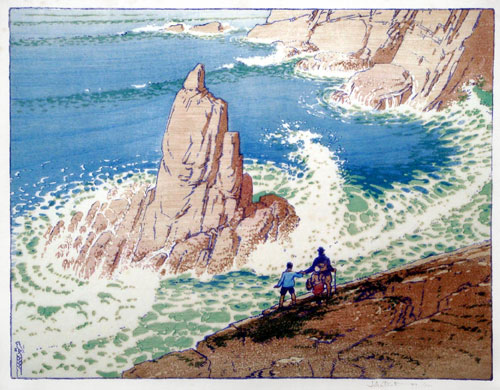Modern
Colour Woodcut
Morley
Fletcher wrote specifically of colour woodcut
“… no
work gives such instruction in economy
of design, in the resources of line and
its expressive development, and in the
use and behaviour of colour.”
though
the observation could stand as a manifesto
for all modern colour relief printmaking.
Some
Modernists felt that the invention of photography
had rendered obsolete painting and printmaking
as a mirror of the external material world
and strove to express the inner reality,
emotional sensations, psychological reactions
and spiritual or abstract concepts that
the camera could not catch. Commensurately
in seeking a formal language they looked
to earlier styles, naïve or folk art,
or to foreign cultures that were not based
on academic realism.
In
the late 1890’s in France, but particularly
in Austria & Germany and in England
artists developed an enthusiasm for colour
woodcuts inspired by the contemporary Japanese
woodblock print and the early Germanic
tradition of woodcut that went back to
the very origins of printmaking. Emil Orlik
was a seminal influence in the development
of the colour print, both relief and intaglio,
as a Professor at Vienna. In 1900 he made
the first of two visits to Japan to experience
their printmaking at first hand.
In
England, F Morley Fletcher began experiments
with J. D. Batten in 1897, cutting blocks
on cherry wood and colour-printing in the
Japanese manner (though not style) with
a principal key block and separate subsidiary
blocks for the various coloured areas,
though several colours could be printed
simultaneously from different relief areas
of the same block.
The
water-based colours were bright, mixed
with rice flour for body, painted onto
the block so that variations in intensity
of colour could be introduced within a
single impression. William Giles and others
went on to devise similar relief prints
from multiple metal plates, etching away
the unwanted areas and printing the flat
metal surface left in relief. Printed in
identical fashion to woodblocks it can
be impossible to tell from an impression
which matrix was used.

John
Platt(1886–1967): "The Irish Lady,
Landsend".
Six-Colour woodcut, 1921-22. (205 x 266 mm)
(Showing the influence of Japanese colour
woodblock prints)
Edvard
Munch, a Norwegian who spent several years
at different periods in Germany and greatly
influenced the German Expressionists, revolutionised
the woodcut and produced some of the greatest
masterpieces of modern European art in
the medium. Often working on a large scale,
Munch sometimes printed his woodcuts in
different colour combinations and even
different block combinations so that each
had a different emotive atmosphere.
Exceptionally
among British artists, Charles Mackie (above
right)
printed with oil-based pigments similar
to traditional printing inks. His relief
prints have a rich painterly, totally European
character. Mackie printed only small editions
and varied the range of colours from one
impression to another, so that though printed
from the same series of multiple blocks
the effect could be very different. |